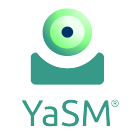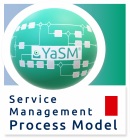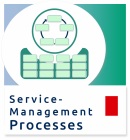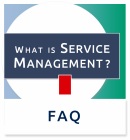ITIL 4 vs ITIL V3: Difference between revisions
No edit summary |
No edit summary |
||
| Line 1: | Line 1: | ||
<itpmch><title>ITIL 4 vs. ITIL V3 | YaSM Service Management Wiki</title> | <itpmch><title>ITIL 4 vs. ITIL V3 | YaSM Service Management Wiki</title> | ||
<meta name="keywords" content="itil v3 vs v4, itil 3 vs itil 4, itil v3 vs itil 4, differences between itil v3 and v4" /> | <meta name="keywords" content="itil v3 vs v4, itil 3 vs itil 4, itil v3 vs itil 4, differences between itil v3 and v4" /> | ||
<meta name="description" content="ITIL V3 vs | <meta name="description" content="ITIL V3 vs ITIL 4: What is new in the current ITIL® version 'ITIL V4'? The main differences between ITIL V3 and ITIL4. Comparison: ITIL 4 practices and ITIL V3 processes. This page describes in detail where ITIL 4 has added new guidance, and how the contents in ITIL 4 can be traced back to specific elements of ITIL V3." /> | ||
<meta property="og:url" content="https://yasm.com/wiki/en/index.php/ITIL_4_vs_ITIL_V3" /> | <meta property="og:url" content="https://yasm.com/wiki/en/index.php/ITIL_4_vs_ITIL_V3" /> | ||
<meta property="og:title" content="ITIL 4 vs. ITIL V3 | YaSM Service Management Wiki" /> | <meta property="og:title" content="ITIL 4 vs. ITIL V3 | YaSM Service Management Wiki" /> | ||
<meta property="og:description" content="Organizations that need to plan their transition to the latest edition of ITIL® will require a detailed mapping between ITIL V3 and ITIL 4: This page describes in detail where ITIL | <meta property="og:description" content="Organizations that need to plan their transition to the latest edition of ITIL® will require a detailed mapping between ITIL V3 and ITIL 4: This page describes in detail where ITIL 4 has added new guidance, and how the contents in ITIL 4 can be traced back to specific elements of ITIL V3." /> | ||
<meta property="og:site_name" content="YaSM Service Management"> | <meta property="og:site_name" content="YaSM Service Management"> | ||
<meta property="og:type" content="article" /> | <meta property="og:type" content="article" /> | ||
| Line 16: | Line 16: | ||
<meta name="pinterest-rich-pin" content="false" /> | <meta name="pinterest-rich-pin" content="false" /> | ||
</itpmch> | </itpmch> | ||
<html><div class="noresize"><a href="https://yasm.com/wiki/de/index.php/ITIL_4_vs_ITIL_V3"><img src="https://yasm.com/wiki/en/img/yasm-wiki/YaSM-Wiki-Deutsch.png" width=" | <html><div class="noresize"><a href="https://yasm.com/wiki/de/index.php/ITIL_4_vs_ITIL_V3"><img src="https://yasm.com/wiki/en/img/yasm-wiki/YaSM-Wiki-Deutsch.png" width="210" height="54" style="float:right;" alt="auf Deutsch" title="This page in German" /></a></div><br style="clear:both;"/> | ||
<p> </p> | <p> </p> | ||
<div itemid="https://yasm.com/wiki/en/img/yasm-frameworks/itil/itil-4-vs-itil-v3-list.jpg" itemscope itemtype="https://schema.org/ImageObject"> | <div itemid="https://yasm.com/wiki/en/img/yasm-frameworks/itil/itil-4-vs-itil-v3-list.jpg" itemscope itemtype="https://schema.org/ImageObject"> | ||
<meta itemprop="caption" content="ITIL 4 vs ITIL V3. - ITIL 4 practices and ITIL V3 processes: How the ITIL 4 practices map to the service lifecycle processes known from ITIL V3." /> | <meta itemprop="caption" content="ITIL 4 vs ITIL V3. - ITIL 4 practices and ITIL V3 processes: How the ITIL 4 practices map to the service lifecycle processes known from ITIL V3." /> | ||
<meta itemprop="width" content="1200" /> | <meta itemprop="width" content="1200" /> | ||
| Line 49: | Line 47: | ||
<meta itemprop="dateCreated" content="2022-06-30" /> | <meta itemprop="dateCreated" content="2022-06-30" /> | ||
<meta itemprop="datePublished" content="2022-06-30" /> | <meta itemprop="datePublished" content="2022-06-30" /> | ||
</span> | |||
<span itemprop="thumbnail" itemscope itemtype="https://schema.org/ImageObject"> | |||
<meta itemprop="url" content="https://yasm.com/wiki/en/img/yasm-frameworks/itil/400px/itil-4-vs-itil-v3-list.jpg" /> | |||
<meta itemprop="width" content="400" /> | |||
<meta itemprop="height" content="300" /> | |||
<meta itemprop="dateCreated" content="2024-09-23" /> | |||
<meta itemprop="datePublished" content="2024-09-23" /> | |||
</span> | </span> | ||
<span itemprop="thumbnail" itemscope itemtype="https://schema.org/ImageObject"> | <span itemprop="thumbnail" itemscope itemtype="https://schema.org/ImageObject"> | ||
| Line 60: | Line 65: | ||
<meta itemprop="keywords" content="ITIL 4 ITIL 2011" /> | <meta itemprop="keywords" content="ITIL 4 ITIL 2011" /> | ||
<meta itemprop="keywords" content="ITIL 4 differences" /> | <meta itemprop="keywords" content="ITIL 4 differences" /> | ||
< | <figure class="mw-halign-right" typeof="mw:File/Thumb"><a itemprop="contentUrl" href="https://yasm.com/wiki/en/img/yasm-frameworks/itil/itil-4-vs-itil-v3-list.jpg" title="ITIL 4 vs. ITIL V3. Comparison: ITIL 4 practices and ITIL V3 processes"><img srcset="https://yasm.com/wiki/en/img/yasm-frameworks/itil/400px/itil-4-vs-itil-v3-list.jpg 400w, https://yasm.com/wiki/en/img/yasm-frameworks/itil/480px/itil-4-vs-itil-v3-list.jpg 480w, https://yasm.com/wiki/en/img/yasm-frameworks/itil/4x3/itil-4-vs-itil-v3-list.jpg 1200w" sizes="100vw" src="https://yasm.com/wiki/en/img/yasm-frameworks/itil/4x3/itil-4-vs-itil-v3-list.jpg" fetchpriority="high" decoding="async" width="480" height="360" class="mw-file-element" alt="Detailed mapping between ITIL V3 and ITIL 4. ITIL 4 practices and ITIL V3 processes: How the ITIL 4 practices map to the service lifecycle processes known from ITIL V3." /></a><figcaption><span style="font-variant:small-caps;"><b>Fig. 1: <a href="https://yasm.com/wiki/en/img/yasm-frameworks/itil/itil-4-vs-itil-v3-list.jpg" title="Comparison ITIL V4 vs. ITIL V3 - list of differences.">What is new in ITIL4? ITIL V3 vs. ITIL 4 - comparison</a></b><br />Differences between ITIL V3 2011 and the latest version of ITIL 4.</span></figcaption></figure></div> | ||
< | |||
<p><span id="md-webpage-description" itemprop="description">Organizations that need to plan their transition to the latest edition of <a href="https://yasm.com/wiki/en/index.php/ITIL" title="What is ITIL?">ITIL</a>® <a href="#ITIL" title="ITIL trademark">[1]</a> will require a detailed mapping between <a href="https://yasm.com/wiki/en/index.php/ITIL#ITIL_V3" title="What is ITIL V3?">ITIL V3</a> and <a href="https://yasm.com/wiki/en/index.php/ITIL#ITIL_4" title="What is ITIL 4 ('ITIL V4')?">ITIL 4</a>:<br /> This page describes in detail <a href="https://yasm.com/wiki/en/index.php/ITIL_4_vs_ITIL_V3#ITIL_4:_What.27s_new.3F" title="What is new in ITIL 4">where ITIL 4 has added new guidance</a>, and how the contents in ITIL 4 can be traced back to specific elements of ITIL V3.</span></html> | |||
<p> </p> | <p> </p> | ||
| Line 70: | Line 74: | ||
==ITIL 4: What's new?== | ==ITIL 4: What's new?== | ||
ITIL 4 - the most current edition of ITIL | ITIL 4 - the most current edition of ITIL® [[#ITIL|[1]]] - was officially released in February 2019. As AXELOS state, "ITIL 4 expands on previous versions by providing a practical and flexible basis to support organizations on their journey to the new world of digital transformation". | ||
ITIL | ITIL 4 is thus an evolution of the familiar ITIL framework rather than a revolution, and still uses many [[#ITIL_4_components_vs._ITIL_V3|fundamental elements]] from the previous version ITIL V3, as first published in 2007 and updated in 2011 ("ITIL 2011"). In particular, many of the new [[#ITIL_4_practices_vs._ITIL_V3_processes|ITIL4 practices correspond to processes known from ITIL V3]]. | ||
==Differences between ITIL V3 and | ==<span id="Differences_between_ITIL_V3_and_V4">Differences between ITIL V3 and ITIL 4</span>== | ||
<p id="ITIL_4_components_vs._ITIL_V3"> </p> | <p id="ITIL_4_components_vs._ITIL_V3"> </p> | ||
{| class="wikitable" style="background: white;" | {| class="wikitable" style="background: white;" | ||
|+style="background:#465674; font-size: 120%; color:#ffffff;"|ITIL V3 vs. | |+style="background:#465674; font-size: 120%; color:#ffffff;"|ITIL V3 vs. ITIL 4 | ||
|-style="vertical-align:top" | |-style="vertical-align:top" | ||
!style="background:#465674; font-size: 110%; color:#ffffff; text-align:left;"|ITIL | !style="background:#465674; font-size: 110%; color:#ffffff; text-align:left;"|ITIL 4 component | ||
!style="background:#465674; font-size: 110%; color:#ffffff; text-align:left;"|Differences: New content in ITIL | !style="background:#465674; font-size: 110%; color:#ffffff; text-align:left;"|Differences: New content in ITIL 4 and how it relates to ITIL V3 | ||
|- | |- | ||
|-style="background:#eeeeee; vertical-align:top; text-align:left; " | |-style="background:#eeeeee; vertical-align:top; text-align:left; " | ||
| Line 123: | Line 127: | ||
| | | | ||
* The ITIL 4 guiding principles are universal recommendations that can guide organizations in many situations, such as "work holistically" and "keep it simple and practical". | * The ITIL 4 guiding principles are universal recommendations that can guide organizations in many situations, such as "work holistically" and "keep it simple and practical". | ||
* These guiding principles are not part of the original ITIL V3 publications, but they have been adopted from [https://www.axelos.com/store/book/itil-practitioner-guidance ITIL | * These guiding principles are not part of the original ITIL V3 publications, but they have been adopted from [https://www.axelos.com/store/book/itil-practitioner-guidance ITIL® Practitioner], a more recent addition to the ITIL V3 portfolio. | ||
|-style="vertical-align:top" | |-style="vertical-align:top" | ||
|<h5>Governance</h5> | |<h5>Governance</h5> | ||
| Line 159: | Line 163: | ||
<p> </p> | <p> </p> | ||
==Has ITIL | ==<span id="Has_ITIL_V4_dropped_the_ITIL_V3_service_lifecycle?">Has ITIL 4 dropped the ITIL V3 service lifecycle?</span>== | ||
A key innovation of ITIL V3 was the introduction of the service lifecycle, consisting of five service lifecycle stages (service strategy, service design, service transition, service operation and continual service improvement). The ITIL V3 processes are distributed across this service lifecycle; for instance, the incident management process is part of the service operation stage. | A key innovation of ITIL V3 was the introduction of the service lifecycle, consisting of five service lifecycle stages (service strategy, service design, service transition, service operation and continual service improvement). The ITIL V3 processes are distributed across this service lifecycle; for instance, the incident management process is part of the service operation stage. | ||
| Line 169: | Line 173: | ||
== Where in ITIL 4 are the ITIL V3 processes? == | == Where in ITIL 4 are the ITIL V3 processes? == | ||
<html> | <html>ITIL V3 defines 26 processes across the service lifecycle. In ITIL 4, these 26 processes have been replaced by 34 "practices" (<a href="https://yasm.com/wiki/en/img/yasm-frameworks/itil/itil-4-practices-itil-v3-processes-comparison.jpg" title="ITIL 4 practices and ITIL V3 processes">see fig. 2</a>).</html> | ||
< | |||
< | Some of them are new, but many of these practices were formerly known as processes. | ||
For a detailed cross-reference, see chapter: [[#ITIL_4_practices_vs._ITIL_V3_processes|Practices vs. processes]]. | |||
<html><div itemid="https://yasm.com/wiki/en/img/yasm-frameworks/itil/itil-4-practices-itil-v3-processes-comparison.jpg" itemscope itemtype="https://schema.org/ImageObject"> | |||
<meta itemprop="caption" content="Overview: ITIL 4 practices and ITIL V3 processes (ITIL 2011 processes)" /> | <meta itemprop="caption" content="Overview: ITIL 4 practices and ITIL V3 processes (ITIL 2011 processes)" /> | ||
<meta itemprop="width" content="1200" /> | <meta itemprop="width" content="1200" /> | ||
| Line 196: | Line 204: | ||
<meta itemprop="keywords" content="ITIL 4 difference" /> | <meta itemprop="keywords" content="ITIL 4 difference" /> | ||
<meta itemprop="keywords" content="ITIL 4 lifecycle" /> | <meta itemprop="keywords" content="ITIL 4 lifecycle" /> | ||
< | <figure class="mw-halign-right" typeof="mw:File/Thumb"><a itemprop="contentUrl" href="https://yasm.com/wiki/en/img/yasm-frameworks/itil/itil-4-practices-itil-v3-processes-comparison.jpg" title="ITIL 4 practices and ITIL V3 processes"><img srcset="https://yasm.com/wiki/en/img/yasm-frameworks/itil/480px/itil-4-practices-itil-v3-processes-comparison.jpg 480w, https://yasm.com/wiki/en/img/yasm-frameworks/itil/itil-4-practices-itil-v3-processes-comparison.jpg 1200w" sizes="100vw" src="https://yasm.com/wiki/en/img/yasm-frameworks/itil/itil-4-practices-itil-v3-processes-comparison.jpg" decoding="async" width="480" height="360" class="mw-file-element" alt="ITIL 4 practices and ITIL 3 processes: 34 management practices from ITIL 4 vs. 26 service lifecycle processes from ITIL V3." /></a><figcaption><span style="font-variant:small-caps;"><b>Fig. 2: <a href="https://yasm.com/wiki/en/img/yasm-frameworks/itil/itil-4-practices-itil-v3-processes-comparison.jpg" title="Comparison: ITIL V4 practices and ITIL V3 processes">ITIL 4 practices and ITIL processes</a></b><br />34 management practices (ITIL 4) vs. 26 service lifecycle processes (ITIL V3).</span></figcaption></figure></div></html> | ||
< | |||
< | |||
So the ITIL V3 processes are still alive, and what is more, the authors of ITIL 4 state that ITIL V3 is still valid guidance that can be used for defining service management processes. | So the ITIL V3 processes are still alive, and what is more, the authors of ITIL 4 state that ITIL V3 is still valid guidance that can be used for defining service management processes. | ||
| Line 212: | Line 212: | ||
This presents an opportunity for a fresh start with ITIL 4 processes, in line with the advice in ITIL 4 to "keep things simple and practical": | This presents an opportunity for a fresh start with ITIL 4 processes, in line with the advice in ITIL 4 to "keep things simple and practical": | ||
<html>The <a class="external text" href="https://yasm.com/en/products/yasm-process-map" title="YaSM® Process Map">YaSM | <html>The <a class="external text" href="https://yasm.com/en/products/yasm-process-map" title="YaSM® Process Map">YaSM® process model</a> describes a <a href="/wiki/en/index.php/Service_Management_Processes" title="Service management processes">streamlined, clear-cut set of service management processes</a> that is a good match for the leaner, more flexible operating models favored by today's service provider organizations.</html><br style="clear:both;"/> | ||
==ITIL 4 practices vs. ITIL V3 processes== | ==ITIL 4 practices vs. ITIL V3 processes== | ||
| Line 318: | Line 318: | ||
!style="background:#eeeeee;"|ITIL 4 manage­ment practice [[#ITIL-4-practices|[4]]] | !style="background:#eeeeee;"|ITIL 4 manage­ment practice [[#ITIL-4-practices|[4]]] | ||
!style="background:#eeeeee;"|Related ITIL V3 processes [[#ITIL-2011-processes|[5]]] | !style="background:#eeeeee;"|Related ITIL V3 processes [[#ITIL-2011-processes|[5]]] | ||
!style="background:#eeeeee;"|ITIL | !style="background:#eeeeee;"|ITIL 4 vs. V3: The changes | ||
|-style="vertical-align:top" | |-style="vertical-align:top" | ||
|Availa­bility manage­ment | |Availa­bility manage­ment | ||
| Line 443: | Line 443: | ||
==References== | ==References== | ||
<span id="ref-axelos-2019">[AXELOS, 2019]. -- AXELOS: ITIL | <span id="ref-axelos-2019">[AXELOS, 2019]. -- AXELOS: ITIL® Foundation, ITIL 4 Edition. - The Stationery Office; Norwich, UK, February 2019.</span><br /> | ||
[a] <span id="ref-cabinet-office-2011a">[Cabinet Office, 2011a]. -- The Cabinet Office: ITIL | [a] <span id="ref-cabinet-office-2011a">[Cabinet Office, 2011a]. -- The Cabinet Office: ITIL® Service Strategy (2011 Edition). - The Stationery Office; London, UK, July 2011.</span><br /> | ||
[b] <span id="ref-cabinet-office-2011b">[Cabinet Office, 2011b]. -- The Cabinet Office: ITIL | [b] <span id="ref-cabinet-office-2011b">[Cabinet Office, 2011b]. -- The Cabinet Office: ITIL® Service Design (2011 Edition). - The Stationery Office; London, UK, July 2011.</span><br /> | ||
[c] <span id="ref-cabinet-office-2011c">[Cabinet Office, 2011c]. -- The Cabinet Office: ITIL | [c] <span id="ref-cabinet-office-2011c">[Cabinet Office, 2011c]. -- The Cabinet Office: ITIL® Service Transition (2011 Edition). - The Stationery Office; London, UK, July 2011.</span><br /> | ||
[d] <span id="ref-cabinet-office-2011d">[Cabinet Office, 2011d]. -- The Cabinet Office: ITIL | [d] <span id="ref-cabinet-office-2011d">[Cabinet Office, 2011d]. -- The Cabinet Office: ITIL® Service Operation (2011 Edition). - The Stationery Office; London, UK, July 2011.</span><br /> | ||
[e] <span id="ref-cabinet-office-2011e">[Cabinet Office, 2011e]. -- The Cabinet Office: ITIL | [e] <span id="ref-cabinet-office-2011e">[Cabinet Office, 2011e]. -- The Cabinet Office: ITIL® Continual Service Improvement (2011 Edition). - The Stationery Office; London, UK, July 2011.</span><br /> | ||
== Notes == | == Notes == | ||
[1] <span id="ITIL">ITIL | [1] <span id="ITIL">ITIL® is a registered trade mark of AXELOS Limited.<br /> | ||
[2] <span id="YaSM">YaSM | [2] <span id="YaSM">YaSM® is a registered trademark of IT Process Maps GbR.</span><br /> | ||
[3] <span id="SIAM">SIAM™ is a registered trademark of EXIN.</span><br /> | [3] <span id="SIAM">SIAM™ is a registered trademark of EXIN.</span><br /> | ||
[4] <span id="ITIL-4-practices">The management practices in this table are based on ITIL 4 Foundation, published in February 2019.</span><br /> | [4] <span id="ITIL-4-practices">The management practices in this table are based on ITIL 4 Foundation, published in February 2019.</span><br /> | ||
| Line 467: | Line 467: | ||
<meta itemprop="position" content="1" /></span> › | <meta itemprop="position" content="1" /></span> › | ||
<span itemprop="itemListElement" itemscope itemtype="http://schema.org/ListItem"> | <span itemprop="itemListElement" itemscope itemtype="http://schema.org/ListItem"> | ||
<a itemprop="item" href="https://yasm.com/wiki/en/index.php/ITIL_4_vs_ITIL_V3# | <a itemprop="item" href="https://yasm.com/wiki/en/index.php/ITIL_4_vs_ITIL_V3#Differences_between_ITIL_V3_and_ITIL_4"> <span itemprop="name">Differences: ITIL V3 and ITIL 4</span></a> | ||
<meta itemprop="position" content="2" /></span> › | <meta itemprop="position" content="2" /></span> › | ||
<span itemprop="itemListElement" itemscope itemtype="http://schema.org/ListItem"> | <span itemprop="itemListElement" itemscope itemtype="http://schema.org/ListItem"> | ||
<a itemprop="item" href="https://yasm.com/wiki/en/index.php/ITIL_4_vs_ITIL_V3# | <a itemprop="item" href="https://yasm.com/wiki/en/index.php/ITIL_4_vs_ITIL_V3#Has_ITIL_4_dropped_the_ITIL_V3_service_lifecycle.3F"> <span itemprop="name">Service lifecycle in ITIL 4</span></a> | ||
<meta itemprop="position" content="3" /></span> › | <meta itemprop="position" content="3" /></span> › | ||
<span itemprop="itemListElement" itemscope itemtype="http://schema.org/ListItem"> | <span itemprop="itemListElement" itemscope itemtype="http://schema.org/ListItem"> | ||
| Line 487: | Line 487: | ||
<link itemprop="url" href="https://yasm.com/wiki/en/index.php/ITIL_4_vs_ITIL_V3" /> | <link itemprop="url" href="https://yasm.com/wiki/en/index.php/ITIL_4_vs_ITIL_V3" /> | ||
<link itemprop="primaryImageOfPage" href="https://yasm.com/wiki/en/img/yasm-frameworks/itil/itil-4-vs-itil-v3-list.jpg" /> | <link itemprop="primaryImageOfPage" href="https://yasm.com/wiki/en/img/yasm-frameworks/itil/itil-4-vs-itil-v3-list.jpg" /> | ||
<link itemprop="Image" href="https://yasm.com/wiki/en/img/yasm-frameworks/itil/itil-4-practices-itil-v3-processes-comparison.jpg" /> | |||
<meta itemprop="inLanguage" content="en" /> | <meta itemprop="inLanguage" content="en" /> | ||
<link itemprop="citation" href="https://yasm.com/wiki/de/index.php/ITIL_4_vs_ITIL_V3" /> | <link itemprop="citation" href="https://yasm.com/wiki/de/index.php/ITIL_4_vs_ITIL_V3" /> | ||
Revision as of 15:04, 22 July 2024
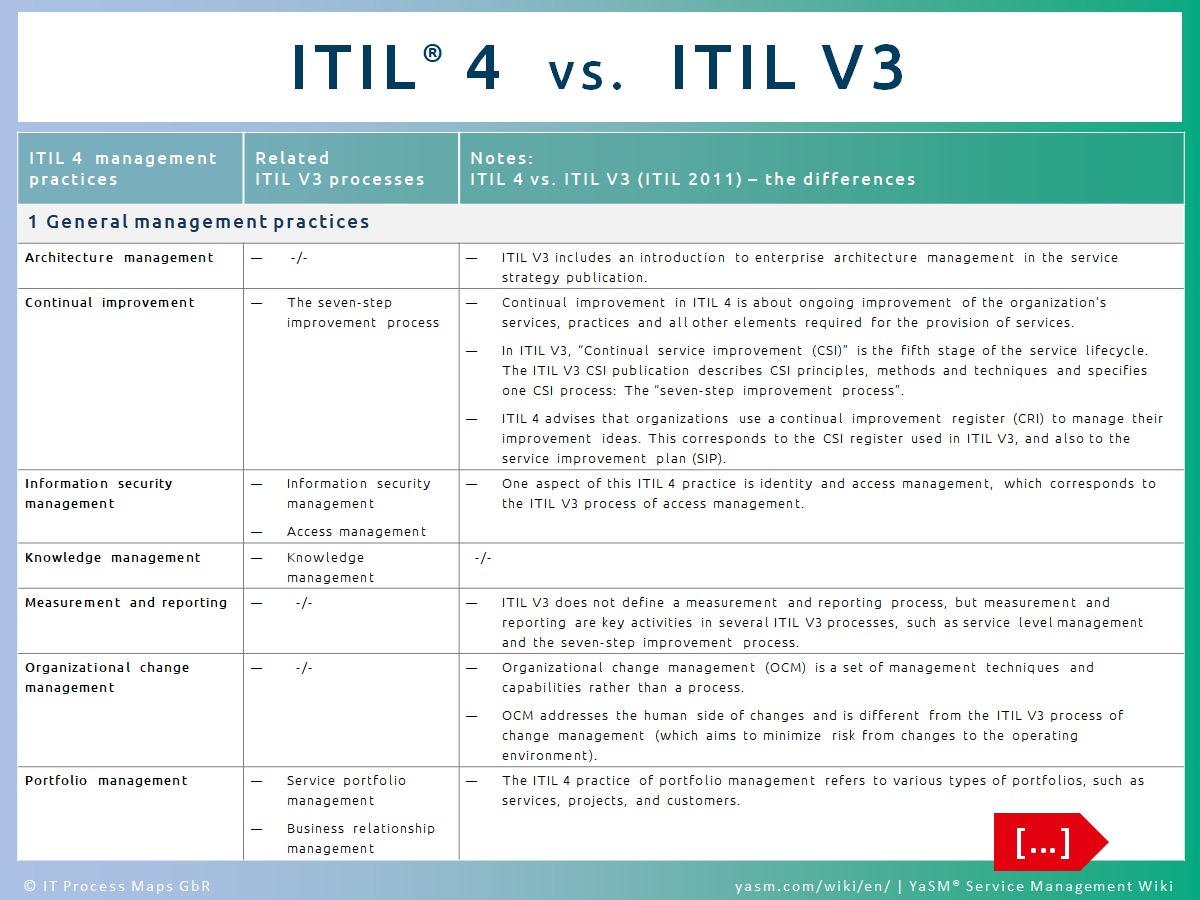
Differences between ITIL V3 2011 and the latest version of ITIL 4.
Organizations that need to plan their transition to the latest edition of ITIL® [1] will require a detailed mapping between ITIL V3 and ITIL 4:
This page describes in detail where ITIL 4 has added new guidance, and how the contents in ITIL 4 can be traced back to specific elements of ITIL V3.
ITIL 4: What's new?
ITIL 4 - the most current edition of ITIL® [1] - was officially released in February 2019. As AXELOS state, "ITIL 4 expands on previous versions by providing a practical and flexible basis to support organizations on their journey to the new world of digital transformation".
ITIL 4 is thus an evolution of the familiar ITIL framework rather than a revolution, and still uses many fundamental elements from the previous version ITIL V3, as first published in 2007 and updated in 2011 ("ITIL 2011"). In particular, many of the new ITIL4 practices correspond to processes known from ITIL V3.
Differences between ITIL V3 and ITIL 4
| ITIL 4 component | Differences: New content in ITIL 4 and how it relates to ITIL V3 |
|---|---|
ITIL 4 key concepts | |
| Key concepts of service management |
|
ITIL 4 four dimensions model | |
| The four dimensions of service management |
|
ITIL 4 service value system (SVS) | |
| Service value system overview |
|
Guiding principles |
|
Governance |
|
Service value chain |
|
Continual improvement |
|
ITIL 4 practices |
|
Remark:
- The ITIL 4 content referenced in this table is based on ITIL 4 Foundation, published in February 2019.
- The ITIL V3 content referenced in this table is based on the 2011 edition of ITIL V3.
Has ITIL 4 dropped the ITIL V3 service lifecycle?
A key innovation of ITIL V3 was the introduction of the service lifecycle, consisting of five service lifecycle stages (service strategy, service design, service transition, service operation and continual service improvement). The ITIL V3 processes are distributed across this service lifecycle; for instance, the incident management process is part of the service operation stage.
The idea behind organizing the ITIL processes in this way was to establish a Deming-like plan-do-check-act cycle focused on continual improvement.
ITIL V4 has dropped most references to the service lifecycle, but continual improvement has remained a key concept. For example, continual improvement is an element of the service value system, and the service value chain with its six activities (plan, improve, engage, design and transition, obtain/build, deliver and support) is very reminiscent of the ITIL V3 service lifecycle.
Where in ITIL 4 are the ITIL V3 processes?
ITIL V3 defines 26 processes across the service lifecycle. In ITIL 4, these 26 processes have been replaced by 34 "practices" (see fig. 2).
Some of them are new, but many of these practices were formerly known as processes.
For a detailed cross-reference, see chapter: Practices vs. processes.
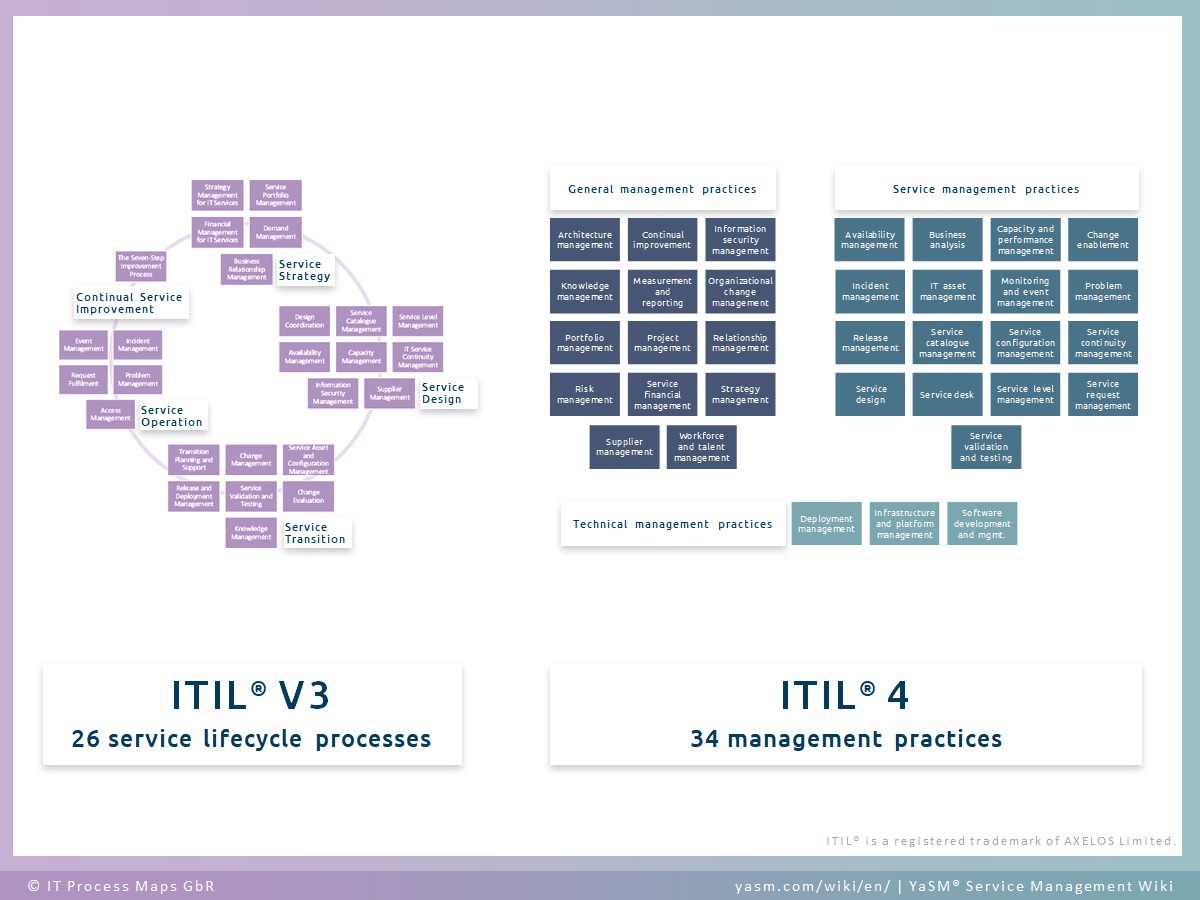
34 management practices (ITIL 4) vs. 26 service lifecycle processes (ITIL V3).
So the ITIL V3 processes are still alive, and what is more, the authors of ITIL 4 state that ITIL V3 is still valid guidance that can be used for defining service management processes.
But it is also worth noting that ITIL 4 is not prescriptive about processes, and gives service providers more freedom to design tailor-made processes that work for the organization.
This presents an opportunity for a fresh start with ITIL 4 processes, in line with the advice in ITIL 4 to "keep things simple and practical":
The YaSM® process model describes a streamlined, clear-cut set of service management processes that is a good match for the leaner, more flexible operating models favored by today's service provider organizations.
ITIL 4 practices vs. ITIL V3 processes
The tables below provide a detailed account of how the ITIL 4 practices map to the service lifecycle processes known from ITIL V3:
| ITIL 4 management practice [4] | Related ITIL V3 processes [5] | Differences: ITIL 3 vs. ITIL 4 |
|---|---|---|
| Architecture management |
-- |
|
| Continual improvement | The seven-step improvement process |
|
| Information security management | Information security management, access management |
|
| Knowledge management | Knowledge management |
|
| Measurement and reporting |
-- |
|
| Organizational change management |
-- |
|
| Portfolio management | Service portfolio management, business relationship management |
|
| Project management | Transition planning and support |
|
| Relationship management | Business relationship management |
|
| Risk management |
-- |
|
| Service financial management | Financial management for IT services |
|
| Strategy management | Strategy management for IT services |
|
| Supplier management | Supplier management |
|
| Workforce and talent management |
-- |
|
| ITIL 4 management practice [4] | Related ITIL V3 processes [5] | ITIL 4 vs. V3: The changes |
|---|---|---|
| Availability management | Availability management |
|
| Business analysis |
-- |
|
| Capacity and performance management | Capacity management, demand management |
|
| Change enablement | Change management, change evaluation |
|
| Incident management | Incident management |
|
| IT asset management |
-- |
|
| Monitoring and event management | Event management |
|
| Problem management | Problem management |
|
| Release management | Release and deployment management |
|
| Service catalogue management | Service catalogue management |
|
| Service configuration management | Service asset and configuration management |
|
| Service continuity management | IT service continuity management (ITSCM) |
|
| Service design | Design coordination, service level management |
|
| Service desk | Incident management, request fulfillment |
|
| Service level management | Service level management |
|
| Service request management | Request fulfillment |
|
| Service validation and testing | Service validation and testing |
|
| ITIL 4 management practice [4] | Related ITIL V3 processes [5] | ITIL 3 vs. ITIL 4: The changes |
|---|---|---|
| Deployment management | Release and deployment management |
|
| Infrastructure and platform management |
-- |
|
| Software development and management |
-- |
|
References
[AXELOS, 2019]. -- AXELOS: ITIL® Foundation, ITIL 4 Edition. - The Stationery Office; Norwich, UK, February 2019.
[a] [Cabinet Office, 2011a]. -- The Cabinet Office: ITIL® Service Strategy (2011 Edition). - The Stationery Office; London, UK, July 2011.
[b] [Cabinet Office, 2011b]. -- The Cabinet Office: ITIL® Service Design (2011 Edition). - The Stationery Office; London, UK, July 2011.
[c] [Cabinet Office, 2011c]. -- The Cabinet Office: ITIL® Service Transition (2011 Edition). - The Stationery Office; London, UK, July 2011.
[d] [Cabinet Office, 2011d]. -- The Cabinet Office: ITIL® Service Operation (2011 Edition). - The Stationery Office; London, UK, July 2011.
[e] [Cabinet Office, 2011e]. -- The Cabinet Office: ITIL® Continual Service Improvement (2011 Edition). - The Stationery Office; London, UK, July 2011.
Notes
[1] ITIL® is a registered trade mark of AXELOS Limited.
[2] YaSM® is a registered trademark of IT Process Maps GbR.
[3] SIAM™ is a registered trademark of EXIN.
[4] The management practices in this table are based on ITIL 4 Foundation, published in February 2019.
[5] The ITIL processes in this table are based on ITIL V3 2011.
By: Stefan Kempter ![]() and Andrea Kempter
and Andrea Kempter ![]() , IT Process Maps.
, IT Process Maps.
What's new? › Differences: ITIL V3 and ITIL 4 › Service lifecycle in ITIL 4 › ITIL 4 processes › ITIL 4 practices vs. ITIL V3 processes

